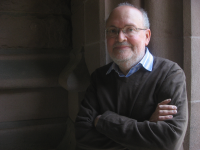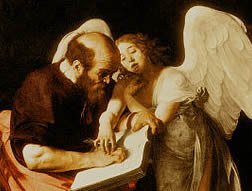Princeton scholar to explore link between poetry and art April 18 at SU
Leonard Barkan analyzes works by Caravaggio, Michelangelo, and Shakespeare

The relationship between poetry and visual art is the subject of a major lecture at Syracuse University. Leonard Barkan, a Princeton University professor and an expert on European culture, will discuss “From Image to Language: Three Vignettes of Work in Transition,” on Thursday, April 18, at 7 p.m. in Maxwell Auditorium. The event is free and open to the public. For more information, contact Hope Glidden at 315-443-5376 or hhglidde@syr.edu.
Barkan’s lecture is organized and presented by the Medieval and Renaissance Faculty Seminar (MEDREN), with generous support from The College of Arts and Sciences, The SU Humanities Center, and the Office of the Chancellor.
“We are honored to present Professor Barkan, a leading authority on the relationship between words and images,” says Glidden, professor of French in the Department of Languages, Literatures, and Linguistics (LLL) and interim director of MEDREN. “In addition to being a masterful writer, he is a thoughtful and sensitive speaker whose analyses appeal to students and scholars alike.”
Barkan’s presentation will likely draw on his latest book, “Mute Poetry, Speaking Pictures” (Princeton University Press, 2013), which explores—in his words—the “deliciously ambiguous history of the relationship between words and pictures."
Barkan’s lecture is organized and presented by the Medieval and Renaissance Faculty Seminar (MEDREN), with generous support from The College of Arts and Sciences, The SU Humanities Center, and the Office of the Chancellor.
“We are honored to present Professor Barkan, a leading authority on the relationship between words and images,” says Glidden, professor of French in the Department of Languages, Literatures, and Linguistics (LLL) and interim director of MEDREN. “In addition to being a masterful writer, he is a thoughtful and sensitive speaker whose analyses appeal to students and scholars alike.”
Barkan’s presentation will likely draw on his latest book, “Mute Poetry, Speaking Pictures” (Princeton University Press, 2013), which explores—in his words—the “deliciously ambiguous history of the relationship between words and pictures."

The vignettes in question are Caravaggio’s “St. Matthew and the Angel” (1602), which depicts the apostle writing his gospel under the influence of an angel; Michelangelo’s vast output of drawings, sketches, and doodles, whose marginal notes reveal expressions of ambition and despair; and Shakespeare’s rich use of foreign language in his plays.
“Professor Barkan will focus on the period from antiquity to the Renaissance, while offering insights that also have much to say about modern art and literature,” says Glidden.
The idea that a poem is like a picture is not new. Since antiquity, writers and artists have debated the merits of their respective work, but their efforts have often raised more questions than answers. Barkan argues that this dialogue is fundamentally an expression of desire—that the painter longs for the rich signification of language and that the poet yearns for the direct sensuousness of painting.
Barkan, who serves as The Class of 1943 University Professor and chair of the Department of Comparative Literature at Princeton, has touched on this phenomenon before in some of his other books: “Michelangelo: A Life on Paper” (Princeton University Press, 2010), “Satyr Square: A Year, a Life in Rome” (Northwestern University Press, 2008), “Unearthing the Past: Archaeology and Aesthetics in the Making of Renaissance Culture” (Yale University Press, 2001), “Transuming Passion: Ganymede and the Erotics of Humanism” (Stanford University Press, 1991), and “The Gods Made Flesh: Metamorphosis and the Pursuit of Paganism” (Yale University Press, 1990).
Much of Barkan’s early work focused on the erotics of humanism, the human body as an image of the world, and pagan mythology as a foundation for modern painting, poetry and esthetics. “More recently, he has turned to the interplay between words and images as an ‘empowering device’ to probe the complex workings of literature and painting,” says Glidden, adding that his scholarship is at once historical and theoretical.
In addition to being an actor and director, Barkan frequently writes about food and wine. He has previously taught at Northwestern University, the University of Michigan, and New York University.
MEDREN is a University-wide group of scholars who share research by conducting a seminar to present papers. Members include professors of art and music histories, classics, English, LLL, religion, philosophy, and other areas in the humanities and social sciences. Last year, MEDREN organized and presented “Sex and Power from the Middle Ages to Enlightenment,” a yearlong program of lectures and seminars supported by the Ray Smith Symposium."
“Professor Barkan will focus on the period from antiquity to the Renaissance, while offering insights that also have much to say about modern art and literature,” says Glidden.
The idea that a poem is like a picture is not new. Since antiquity, writers and artists have debated the merits of their respective work, but their efforts have often raised more questions than answers. Barkan argues that this dialogue is fundamentally an expression of desire—that the painter longs for the rich signification of language and that the poet yearns for the direct sensuousness of painting.
Barkan, who serves as The Class of 1943 University Professor and chair of the Department of Comparative Literature at Princeton, has touched on this phenomenon before in some of his other books: “Michelangelo: A Life on Paper” (Princeton University Press, 2010), “Satyr Square: A Year, a Life in Rome” (Northwestern University Press, 2008), “Unearthing the Past: Archaeology and Aesthetics in the Making of Renaissance Culture” (Yale University Press, 2001), “Transuming Passion: Ganymede and the Erotics of Humanism” (Stanford University Press, 1991), and “The Gods Made Flesh: Metamorphosis and the Pursuit of Paganism” (Yale University Press, 1990).
Much of Barkan’s early work focused on the erotics of humanism, the human body as an image of the world, and pagan mythology as a foundation for modern painting, poetry and esthetics. “More recently, he has turned to the interplay between words and images as an ‘empowering device’ to probe the complex workings of literature and painting,” says Glidden, adding that his scholarship is at once historical and theoretical.
In addition to being an actor and director, Barkan frequently writes about food and wine. He has previously taught at Northwestern University, the University of Michigan, and New York University.
MEDREN is a University-wide group of scholars who share research by conducting a seminar to present papers. Members include professors of art and music histories, classics, English, LLL, religion, philosophy, and other areas in the humanities and social sciences. Last year, MEDREN organized and presented “Sex and Power from the Middle Ages to Enlightenment,” a yearlong program of lectures and seminars supported by the Ray Smith Symposium."
Media Contact
Rob Enslin
